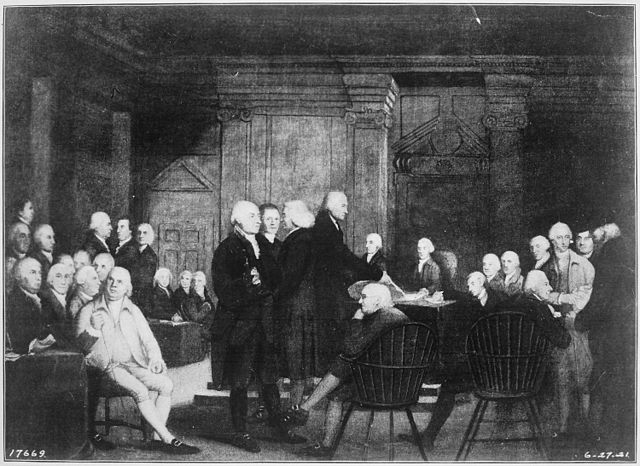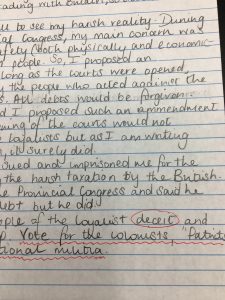
The Second Continental Congress voting for independence from Great Britain.
When my student Patrice was arrested, I was amused. We were in my English 1101 seminar, “Romantic Revolutions,” and Patrice had been assigned the role of an indebted farmer in 1770s New York. My class was using Patriots, Loyalists & Revolution in New York City, 1775-76 to revive the independence debates of late-1770s America. As the book’s title suggests, students were asked to assume the roles of patriots, loyalists, and undecided others. Patrice’s character, James Carpenter [1], was among the undecided. James was a representative to the makeshift New York Provincial Congress; he was not certain if war or reconciliation with the British was the right path for New York. James also had debts, and while Patrice attempted to find a way to pay (or dodge) them, ultimately, they were collected on in the arrest.
This strange situation is a product of Reacting to the Past, which the creators describe as a series of historical simulations “in which students are assigned roles informed by classic texts in the history of ideas” that are written and peer-reviewed by higher-education faculty. While the Reacting curriculum is often used in history and political sciences classrooms—from introductory courses to upper-division seminars—it is not frequently used in writing and literature courses [2]. Nevertheless, I have found Reacting to be one excellent way to teach rhetoric, multimodal composition, and literature.
Reacting emphasizes reading primary source documents and writing in response to those documents in attempts to persuade peers. This is why I believe that Reacting is an especially good fit for teaching multi-modal composition, as the simulations ask students to compose and present through many different modes: essays, newspapers, speeches, posters, and so on. But unlike a more traditional classroom where students write to persuade hypothetical audiences who never respond, in a Reacting classroom the students’ audience is their very responsive classmates. Persuasion tends to be chaotic and messy, and the Reacting classroom is no different: in Patrice’s seminar the loyalists who opposed a boycott of British goods were accused of merely acting in their own self-interest, an attack they had difficulty refuting. The boycott passed, and loyalists were further cut off from Britain.
Volatile scenes like this generate what Rosa Eberly calls a “proto-public” space. Eberly writes that the classroom-as-proto-public: “encourage[s] students to see themselves as actors in different and overlapping publics can help them realize the particular and situated nature of rhetoric and the need for effective writing to respond to particular needs of particular publics” (167). In these spaces, students manage the classroom, lead debates, and make policy choices. Rather than look to their instructor to control or evaluate discussion, they assume the agency and discursive responsibility that structure civic and professional arenas. Put otherwise, Reacting emphasizes that applying rhetoric and understanding multiple modalities of communication means understanding an array of audiences, and figuring out how best to talk with those audiences. As Eberly states, students determine how “to respond to particular needs of particular publics.” Patrice’s experiences with Patriots, Loyalists & Revolution in New York City, 1775-76 are good examples of this: she learned to shape her rhetorical approach over the course of the game, tailoring her appeals to particular publics as they collided in the months before the Revolutionary War. To better understand those experiences, I sat down with Patrice and asked her about them.

Patrice Gill
Patrice Gill is from Barbados, and came to Georgia Tech to earn a biomedical engineering degree. She says: “I always wanted to be a doctor until I was sixteen. Then I went to a University of the West Indies engineering camp. I really liked the camp and got real insights from professional engineers about how biomedical engineering can help save lives.” As fits with the “two cultures” divide between the sciences and the humanities (which only seems to be widening), Patrice says she was never really enthusiastic about literature, rhetoric, or writing: “I am definitely more of a STEM person. In school I did not like English. I liked science. English was boring. In my STEM classes we got to do labs where we would we play with resistors and capacitors or dissect pig hearts. In English we would just write papers where we would summarize multiple forms of poetry.” Nevertheless, Patrice enthusiastically approached our course, offering insightful comments on works by John Locke, Samuel Johnson, and Thomas Paine. As we prepared to start our recreation, she drafted speeches and did research to better understand James’s perspective.
Patrice’s journey vis-à-vis James through 1775 New York was unremarkable at first. As an undecided character, she listened, evaluated, and voted based on the effectiveness of her peers’ rhetoric. Using a character sketch from the Reacting materials—a nine-page document that included James’ biography, ideological objectives, relationship with the core texts, and a bibliography for where to find more information—Patrice had to think about what James and his constituents wanted, and then weigh legislation based on the arguments he heard. This process, trying to think as James, gave Patrice a poor opinion of the colonial farmer: “He was just concerned about what others thought of him. He wanted to be viewed as respectable. He put his personal interests before the majority, the poor, or anyone like that. He needed to have something to sell to make money. He was not a fighter. I don’t want to say a coward, but he was a coward. He was not a leader, a changer; I can’t really get down with that. I stand for something, he doesn’t, but I can understand why he thought what he did.” Patrice did her best to channel James’s perspective and concerns during debate.
One of her first tasks was to critique the ideologies of the opposing patriot and loyalist factions. From a pedagogical perspective, the speech served to push the other members of the Congress to be more rhetorically savvy while also evincing James’s neutrality. For example, Patrice questioned the loyalists on whether British taxation was actually providing benefits to the colonies. Moments later though, she questioned the patriots on their use of violent mobs to achieve political ends. To make her points, Patrice cited both Locke and Johnson (among others), using them to reinforce her criticisms of the factions. In the speech shown here, she used the writers to acknowledge the debt the Colonies owe to Britain, but also questioned whether Locke’s tacit consent meant uncritically accepting any and all taxation. The well-received speech established James as a significant opinion-maker during the opening sessions of the Provincial Congress.
As the summer of 1775 became winter, the tensions between the American colonies and its British rulers flared, especially after King George III declared the colonies to be in “open and avowed rebellion.” In these times, the relative stability that James had enjoyed ended as a wealthy, loyalist merchant came to collect on James’s debt. The merchant had not been swayed by Patrice’s critique of British taxation; in fact, Patrice’s argument had made her a few enemies in the Congress, including the merchant. The loyalist merchant was scared: the colonies were slipping towards chaos and, given the attacks on loyalist businesses, he was likely to lose everything if war were declared. Jailing James was one way to eliminate a voice that seemed partisan and potentially stop lurching towards destruction. When the merchant demanded James pay-up or be jailed, Patrice was uncertain how to respond at first: “My initial thought was to stay neutral. But I was desperate, I started asking anyone for money. I made a deal with a patriot leader. But then he decided to start a mob for his own goals. And I still owed the money.”

A selection from James Carpenter’s letter from a New York City Jail.
I remember Patrice was crestfallen when James was thrown into debtor’s prison. Unprompted, she asked me how she might respond despite being incarcerated. This was not an assignment for the course, as her speech had been; Patrice was simply motivated to speak out against loyalist hypocrisy. In a meeting, I pointed out to Patrice that prison has not always been an impediment to rhetoric—as Martin Luther King Jr. demonstrated in “Letter from a Birmingham Jail”—and encouraged her to write from James’s cell to convince the members of the Congress that the loyalist were acting unjustly. Writing the letter, Patrice notes, was more emotional than she’d expected: “I was actually upset! How could the loyalists do me like this? My speech was very vengeful. I thought, ‘Let me just point out everything that the Loyalists have done wrong.’ I was just angry at this point. The loyalists themselves caused me to be in this situation and then punished me for being in this situation!”
The letter was well-calibrated to the changing rhetorical situation around the Provincial Congress; in content and tone it was just what the patriots needed. What I found remarkable about this letter was that Patrice had seized on the fact that her audience was not in front of her. Rather, it was the disenfranchised people in the gallery and outside the Congress who felt wronged by the loyalists. She had successfully assessed her audience and adjusted her rhetoric to appeal to them by foregrounding “the hardships we endure because of our financial uncertainty” and by calling out “the harsh taxation by the British.” Like Thomas Paine, Patrice emphasized the passions of the colonial cause, casting aside the more distant analysis from her previous speech. The letter was read aloud in the Provincial Congress and effectively persuaded both undecided voters and disenfranchised laborers, women, and enslaved blacks. A mob formed—a mass of students surrounding Patrice chanting “James” with interjections of “down with the King” and “To hell with George”—freeing James from prison and allowing the patriots to take control of the Provincial Congress.
In the spring of 1776, the patriot-controlled congress attempted to form a militia and reinforce the city’s defenses. Unfortunately, their preparations were not enough, and General Howe captured the city pushing General Washington back. Despite the patriots’ defeat in New York, Patrice felt like she had won by adapting to a particular public, by finding a way to reach her audience through her letter. In terms of her investment in the course, Patrice said that Reacting was one of the more engaging ways she had ever encountered history: “Instead of learning about American Revolution we were actually immersed in the Revolution, and reacting to it. I have a deeper understanding of the revolution for the game.”

The Battle of Harlem Heights, September 16, 1776
In the context of English 1101, Patrice described how she came to have a better understanding of rhetoric and its applications: “I would say actually being in the moment changed how I viewed rhetoric. Whenever I have to write an essay now I can actually think about what it would be like to be in the moment. The game forced me to adapt to changing situations. When you are persuading people, you have to think about the situation. Given that people have agenda, you have to be careful and really think about your argument, and taking into consideration people’s personal agendas.”
I am not alone in believing that this kind of rhetorical awareness—being thoughtful about audience, situation, and medium—is crucial to civic engagement in the 21st century. Many people approach rhetoric as objective or empirical, holding that only logical, factual, or scientific arguments will persuade. Any engagement with public discourse in the United States demonstrates the falsity of that view; just look at the ‘debate’ around Climate Change in the US. The science is settled, yet arguments persist. My impression of Georgia Tech students is that they are pragmatic problem-solvers, and certainly Tech markets itself as focused on solving problems. But technological solutions without a concerted understanding and attention to a society’s culture—its beliefs, norms, and habits—are destined for delay or failure.
Thus, one of my pedagogical aims is to encourage resilience in my students: to prepare them to move through fluid intellectual situations and respond to defeat positively. These, I believe, are the tools they need to critique complex systems and shape culture. Reacting provides an opportunity for my students to learn resilience as they are stymied and detained (not just figuratively) by shifting circumstances. What inspires me about Patrice’s choices is that rather than merely accepting that she had been arrested, she found ways to persist by adapting her thoughts for variable contexts: in this case, writing her argument rather than speaking it. In the face of adversity, she was persistent and undeterred. I take her actions as a testament, then, to the promise of this reversed-classroom, a space where an undergraduate becomes a colonial farmer in the American Revolution, and students gain the aperture to experience a sliver of history, to fail fruitfully, and to find tools for success in the 21st century.

American Soldiers at the Siege of Yorktown (1781) by Jean-Baptiste-Antoine DeVerger
Notes
[1] Name changed to protect the integrity of the role for any other courses that use Patriots, Loyalists & Revolution in New York City, 1775-76.
[2] There are English scholars who are using Reacting in their classes, such as Bethany Holmstrom and Christina Katopodis. Joan Varnum Ferretti argues in favor of Reacting in the survey class in the newly released Teaching the Literature Survey Course: New Strategies for College Faculty (2018), and Dr. Anna Bertolet of Auburn University remarks in a recent article on Reacting: “It’s my dream that one day this learning model will be employed in all first-year English classrooms.”
Works Cited
Eberly, Rosa A. “From Writers, Audiences, and Communities to Publics: Writing Classrooms as Protopublic Spaces.” Rhetoric Review, Vol. 18, No. 1, Autumn 1999, pp. 165-178.
George III of the United Kingdom (George William Frederick). “Declaration of Rebellion.” 23 August 1775.
Gill, Patrice. Personal interview. 8 November 2018.
King Jr., Martin Luther. “Letter from a Birmingham Jail.” 16 April 1963.
Offutt, Bill. Patriots, Loyalists, and Revolution in New York City, 1775-1776. 2nd Ed. W. W. Norton, 2015.
